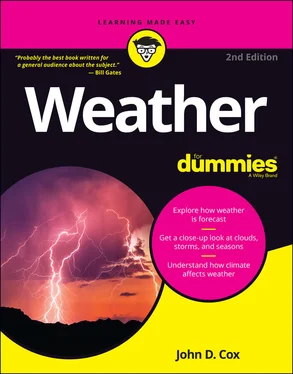In the pages of Weather For Dummies are a set of symbols that alert you to certain kinds of information. They help you sort through the wide variety of facts and details and put them in your own order. Here’s what these symbols mean.
 This icon lets you know about a concept, or big idea, that is not just a detail about the weather, but is a whole train of thought on a subject. Big ideas are not complicated. In fact, they are simple. They’re important, or big, and worth checking out, because they help explain a lot of details.
This icon lets you know about a concept, or big idea, that is not just a detail about the weather, but is a whole train of thought on a subject. Big ideas are not complicated. In fact, they are simple. They’re important, or big, and worth checking out, because they help explain a lot of details.
 Some words are just weather words. There are a whole lot of special weather words that scientists use all the time when talking to each other, and this book avoids most of them. The ones you find at this symbol are included because they are helpful or interesting.
Some words are just weather words. There are a whole lot of special weather words that scientists use all the time when talking to each other, and this book avoids most of them. The ones you find at this symbol are included because they are helpful or interesting.
 Some kinds of information are valuable because they make complicated easy or they help cut through a lot of detail to a useful idea. That’s the kind of thing this symbol points out, an idea that makes things a little quicker or easier.
Some kinds of information are valuable because they make complicated easy or they help cut through a lot of detail to a useful idea. That’s the kind of thing this symbol points out, an idea that makes things a little quicker or easier.
 A lot of details are useful only to a specific subject, but some things are valuable to keep in mind because they help explain a variety of things. That kind of good-to-remember information is what this symbol identifies.
A lot of details are useful only to a specific subject, but some things are valuable to keep in mind because they help explain a variety of things. That kind of good-to-remember information is what this symbol identifies.
 Some weather situations are so dangerous that they should be avoided always. Most of the dangers are pretty obvious, but not all of them. This symbol alerts you to extreme weather conditions where dangers are clear and present. It also points you to tips about what to do if you are hurt by the weather.
Some weather situations are so dangerous that they should be avoided always. Most of the dangers are pretty obvious, but not all of them. This symbol alerts you to extreme weather conditions where dangers are clear and present. It also points you to tips about what to do if you are hurt by the weather.
 Don’t be alarmed by this nerdy-looking guy. The technical stuff included in this book is not really the heavy-duty number-crunching kind of thing that weather scientists do once in a while. This symbol alerts you to stuff that’s just a little more technical than the rest.
Don’t be alarmed by this nerdy-looking guy. The technical stuff included in this book is not really the heavy-duty number-crunching kind of thing that weather scientists do once in a while. This symbol alerts you to stuff that’s just a little more technical than the rest.
A Note about Measurements
Because this book is published in the United States, I have adhered fairly closely to the use of imperial measures of temperature and length (degrees Fahrenheit and inches) rather than their metric counterparts (degrees Celsius and centimeters), which are used more commonly by the rest of the world. Chapter 2has a Fahrenheit to Celsius conversion chart that may be helpful, and Chapter 4, which discusses the amounts of rainfall and other precipitation, includes a chart that converts inches to centimeters and millimeters.
In addition to the abundance of information and guidance related to weather that I provide in this book, you get access to even more help and information online at Dummies.com . Check out this book’s online Cheat Sheet. Just go to www.dummies.com and search for “Weather For Dummies Cheat Sheet.”
Go outside. I mean it. You’ve been spending too much time indoors, anyway, so close this book temporarily, tuck it under your arm, and head out the door. Go outside and give your sky a good looking-over. It’s your sky, and it’s your weather, because nobody else sees it or feels it exactly like you do. Are there clouds up there? Do you know how they form or what their names are? Do you know how much fun it is to start practicing identifying the clouds in your sky? If you don’t, it’s time to come back inside and open Weather For Dummies again. Chapter 6is a good place to start.
Part 1
What’s Going On Up There?
IN THIS PART …
Discover weather science’s most popular finished product: the daily weather forecast. See what goes into making state-of-the-art accurate forecasts and understanding how to interpret them.
Wrap your mind around weather words — precipitation, temperature, humidity, highs and low, wind chill, among others — and what they mean in your local forecast.
Find out about the things that make the atmosphere and its weather the way it is — so changeable — here today, gone tomorrow, as the saying goes.
Find the answer to the question, “What is fog, exactly?” as well as how the oceans and the land masses affect your weather.
Chapter 1
What in the World Is Weather?
IN THIS CHAPTER
 Looking at our imperfect planet
Looking at our imperfect planet
 Exploring the weather forecast
Exploring the weather forecast
 Hanging with the weather celebrities
Hanging with the weather celebrities
Earth is not a perfect planet. (It may well be that none of them are, but, you know, who are we to say?) It is not perfectly round, for one thing. One half of it has a lot of land with mountains and valleys, the other half, not so much. It circulates (once a year) around the Sun, its energy-supplying star, but the path it takes is not perfectly circular either. It is not perfectly upright, for another thing, the way you might expect a perfect planet to be. In relation to the Sun, it is seriously akilter, spinning (once a day) on a 23-degree tilt, as if it has been knocked over by something. On top of everything is the atmosphere, this brew of nitrogen and oxygen and other gases that make up the air we breathe. This ocean of air swirls along like the planet itself — but not perfectly.
All these imperfections create imbalances of heat and cold, wet and dry that keep the atmosphere in motion, like a soft body squirming in a hard seat. These motions of an uncomfortable atmosphere always looking for balanced perfection — this squirming, that’s what we call weather. It doesn’t just make life interesting, by the way; it supplies our fresh air and our fresh water. It makes life possible.
In this chapter, I give you a quick survey of the subject of meteorology — weather science — and where in Weather For Dummies you can find more information about each topic. Beginning with the product we encounter every day and moving on to explore how the atmosphere’s changing chemical composition is hitting the ground, let’s take a look at what’s in store.
The Daily Forecast: A Scientific Marvel
Weather For Dummies begins with weather science’s most popular finished product: the daily forecast. Without all the numbers and equations, the first part of the book describes what goes into making a forecast and understanding what it means. It lays out the terms that apply and the circumstances that make up weather emergencies.
Before we get into the details of the weather science behind it in Chapter 2, though, take a closer look at the next televised weather forecast you see. You will probably see a sharp, full-color image of half the Earth, captured in real time by a satellite that is constantly hovering 22,300 miles above the planet. You will see great arms and swirls of clouds crawling across the landscape, the signatures of storms. Even without explanation, you can see where the storms have been and surmise where they are going.
Читать дальше

 This icon lets you know about a concept, or big idea, that is not just a detail about the weather, but is a whole train of thought on a subject. Big ideas are not complicated. In fact, they are simple. They’re important, or big, and worth checking out, because they help explain a lot of details.
This icon lets you know about a concept, or big idea, that is not just a detail about the weather, but is a whole train of thought on a subject. Big ideas are not complicated. In fact, they are simple. They’re important, or big, and worth checking out, because they help explain a lot of details. Some words are just weather words. There are a whole lot of special weather words that scientists use all the time when talking to each other, and this book avoids most of them. The ones you find at this symbol are included because they are helpful or interesting.
Some words are just weather words. There are a whole lot of special weather words that scientists use all the time when talking to each other, and this book avoids most of them. The ones you find at this symbol are included because they are helpful or interesting. Some kinds of information are valuable because they make complicated easy or they help cut through a lot of detail to a useful idea. That’s the kind of thing this symbol points out, an idea that makes things a little quicker or easier.
Some kinds of information are valuable because they make complicated easy or they help cut through a lot of detail to a useful idea. That’s the kind of thing this symbol points out, an idea that makes things a little quicker or easier. A lot of details are useful only to a specific subject, but some things are valuable to keep in mind because they help explain a variety of things. That kind of good-to-remember information is what this symbol identifies.
A lot of details are useful only to a specific subject, but some things are valuable to keep in mind because they help explain a variety of things. That kind of good-to-remember information is what this symbol identifies. Some weather situations are so dangerous that they should be avoided always. Most of the dangers are pretty obvious, but not all of them. This symbol alerts you to extreme weather conditions where dangers are clear and present. It also points you to tips about what to do if you are hurt by the weather.
Some weather situations are so dangerous that they should be avoided always. Most of the dangers are pretty obvious, but not all of them. This symbol alerts you to extreme weather conditions where dangers are clear and present. It also points you to tips about what to do if you are hurt by the weather. Don’t be alarmed by this nerdy-looking guy. The technical stuff included in this book is not really the heavy-duty number-crunching kind of thing that weather scientists do once in a while. This symbol alerts you to stuff that’s just a little more technical than the rest.
Don’t be alarmed by this nerdy-looking guy. The technical stuff included in this book is not really the heavy-duty number-crunching kind of thing that weather scientists do once in a while. This symbol alerts you to stuff that’s just a little more technical than the rest. Looking at our imperfect planet
Looking at our imperfect planet










